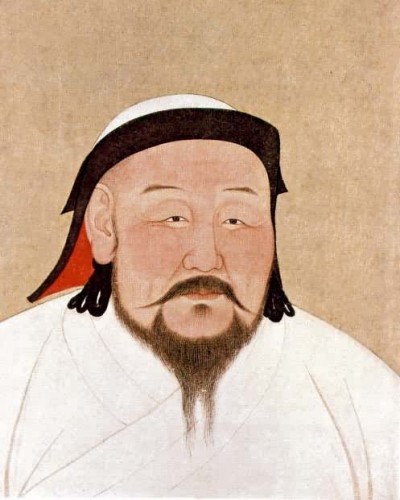Temujin, also called Genghis Khan, is likely the most successful conquer in world history. He helped to create the largest contiguous empire in human history, stretching across Asia and parts of Eastern Europe. Temujin success is impressive especially considering his background. Temujin was born in 1162 in modern day Mongolia. At the age of 12 his father was poisoned and his entire family abandoned by their tribe leaving Temujin, his mother, step-mother and several sibling alone to fend for themselves. With the hard work of him and the mothers, the family was able to avoid death by starvation or freezing. Temujin eventually married a women named Börte however soon after his wife was kidnapped. Temujin looked for assistance to try and save his wife and found assistance from a friend of his named Jamukha who’s family would often make camp in an area near that of Temujin’s family. The kidnapping of his wife led Temujin to the conclusion that a quiet life with his family would not be possible and if he wished to make sure people would not steal or get in his way the best way to do so was to gain power. Through alliances, success in combat, political decisions favoring ordinary people over the ruling class and eventual splits and defeating of former allies, Temujin was able to become great Khan (or Genghis Khan) of the Mongols in 1206. Temujin continued to conquer until his death leaving an empire that would continue to expand throughout Europe and Asia for about a half a century.
Though Genghis Khan has been antagonized in Western cultures, the empire accomplished many great things. The main things which they brought were items and knowledge about far away countries. The Mongols spread things like religious tolerance, open markets, secular politics, paper money, playing cards, and a universal alphabet from Asia to Europe and vice versa. Genghis Khan was also a unique military leader as he was brutal to the ruling class of the places he conquered but reasonable lenient to commoners and reward well those that were loyal to him. Usually in such battles the ruling class would be the one which would be treated well while the commoners suffered but Genghis Khan took the opposite approach which allowed him to be able to take over cities with less risk of rebellion.
Genghis Khan died a successful man however the story of his life as well as his final resting place was well hidden. Mongol tradition discouraged people talking about the dead which limited the ability for documentation to be created within Mongolia about Genghis Khan’s exploits and helped in allowing for the villianization of Temujin because most written accounts about him and his people were made outside of Mongolia. Some documentation made by the Mongols about Genghis Khan has been found however which has allowed for some information about the conquer’s life to come to light. The most notable of these documents is the Secret History of Mongolia which is now considered one of the most important documents of Mongolian history in existence.
After Tenujin’s death his body was moved to a secret location goes. There are claims that all of the people who helped in moving the body were killed as to stop anyone knowing where is final resting place was however it is likely that his final resting place is near where he was born. Likely he was buried in between the Onon River and the Burkhan Khaldun Mountain. Being near the Burkhan Khaldun Mountain would have been of particular importance for the Khan as it was the place where he would often go to worship and pray. Ultra-high resolution satellite imaging is being used to try and locate the tomb but it has not yet been found.
The tomb is not the only “resting place” of Genghis Khan that researchers have been searching for. Temujin’s tribe did not believe that the soul of Genghis Khan stayed with his body after death and instead it was kept in his spirit banners or “suldes”. The suldes were made out of horse hair and were carefully guarded as there destruction would mean the destruction of its owner’s spirit. Temujin had two banners, one white and one black the white sulde was used during Tenujin’s life time as a sign of peace and the black one was used for war. The white banner has been missing for centuries but the black one only disappeared during the great purges done by the Soviets in Mongolia to eliminate religious, government and intellectual figures within the country during the late 1930s. It is unclear if the Soviets took the banner from the monastery that held it and destroyed it or if it is currently hidden somewhere. Unlike the tomb ultra-high resolution satellites will be of little help in locating the missing banner. There has been little to no leads to help in locating the banner however after the Soviets left Mongolia in the 1990s a white version of the banner began to be used as a symbol of the country of Mongolia. This was likely done in part to respond to the years of cultural and historic suppression of the Mongols during the Soviet’s occupation.
There is a strong interest in Genghis Khan within Mongolia, a desire to learn about the great conquer that has only grown after the departure of the Soviets. As time goes on and archeological work continues knowledge of the great conquer will only increase and eventually it will hopefully lead to the body and spirit of Genghis Khan being discovered.

